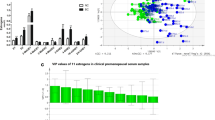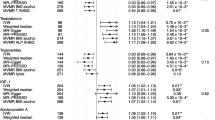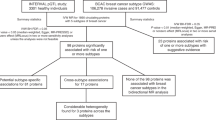Abstract
Polymorphisms within the estrogen metabolic pathway are prime candidates for a possible association with breast cancer risk. We investigated 11 genes encoding key proteins of this pathway for their potential contribution to breast cancer risk. Of these CYP17A1, CYP19A1, EPHX1, HSD17B1, SRD5A2, and PPARG2 participate in biosynthesis, CYP1A1, CYP1B1, COMT, GSTP1, and SOD2 in catabolism and detoxification. We performed a population-based case-control study with 688 incident breast cancer cases and 724 controls from Germany and genotyped 18 polymorphisms by matrix assisted laser desorption/ionization time-of-flight mass spectrometry (MALDI-TOF MS), PCR based RFLP (restriction fragment length polymorphism), and TaqMan® allelic discrimination. Genotype frequencies were compared between cases and controls and odds ratios were calculated by conditional logistic regression. Further statistical analyses were based on cluster analysis, multifactor dimensionality reduction, logic regression, and global testing. Single factor analyses pointed to CYP1B1_1294_GG as a possible breast cancer risk modulator (OR = 2.57; 95% CI: 1.34–4.93) and two way stratification suggested associations between BMI ≥ 30 kg/m2 and COMT_472_GG (P = 0.0076 and P = 0.0026), BMI < 20 kg/m2 and HSD17B1_937_GG (P = 0.0082) as well as CYP17A1_-34_CC and HRT use ≥10 years (P = 0.0063). Following correction for multiple testing none of these associations remained significant. No significant association between breast cancer risk and genetic polymorphisms was observed in multifactor analyses. The tested polymorphisms of the estrogen metabolic pathway may not play a direct role in breast cancer risk. Therefore, future association studies should be extended to other polymorphisms and other regulatory pathways.
Similar content being viewed by others
References
Parkin DM, Bray F, Ferlay J et al (2005) Global cancer statistics, 2002. CA Cancer J Clin 55:74–108
Stewart BW, Kleihues P (2003) World cancer report. IARC Press, Lyon
Malone KE, Daling JR, Doody DR et al (2006) Prevalence and predictors of BRCA1 and BRCA2 mutations in a population-based study of breast cancer in white and black American women ages 35 to 64 years. Cancer Res 66:8297–8308
Walsh T, Casadei S, Coats KH et al (2006) Spectrum of mutations in BRCA1, BRCA2, CHEK2, and TP53 in families at high risk of breast cancer. Jama 295:1379–1388
Wooster R, Weber BL (2003) Breast and ovarian cancer. N Engl J Med 348:2339–2347
Meijers-Heijboer H, van den Ouweland A, Klijn J et al (2002) Low-penetrance susceptibility to breast cancer due to CHEK2(*)1100delC in noncarriers of BRCA1 or BRCA2 mutations. Nat Genet 31:55–59
Rahman N, Seal S, Thompson D et al (2007) PALB2, which encodes a BRCA2-interacting protein, is a breast cancer susceptibility gene. Nat Genet 39:165–167
The CHEK2 Breast Cancer Case-Control Consortium (2004) CHEK2*1100delC and susceptibility to breast cancer: a collaborative analysis involving 10,860 breast cancer cases and 9,065 controls from 10 studies. Am J Hum Genet 74:1175–1182
Cox A, Dunning AM, Garcia-Closas M et al (2007) A common coding variant in CASP8 is associated with breast cancer risk. Nat Genet 39:352–358
Yager JD, Davidson NE (2006) Estrogen carcinogenesis in breast cancer. N Engl J Med 354:270–282
Key TJ, Allen NE, Spencer EA et al (2002) The effect of diet on risk of cancer. Lancet 360:861–868
Zumoff B (1998) Does postmenopausal estrogen administration increase the risk of breast cancer? Contributions of animal, biochemical, and clinical investigative studies to a resolution of the controversy. Proc Soc Exp Biol Med 217:30–37
Beral V (2003) Breast cancer and hormone-replacement therapy in the million women study. Lancet 362:419–427
Pesch B, Ko Y, Brauch H et al (2005) Factors modifying the association between hormone-replacement therapy and breast cancer risk. Eur J Epidemiol 20:699–711
Rossouw JE, Anderson GL, Prentice RL et al (2002) Risks and benefits of estrogen plus progestin in healthy postmenopausal women: principal results from the women’s health initiative randomized controlled trial. Jama 288:321–333
Collaborative Group on Hormonal Factors in Breast Cancer (1996) Breast cancer and hormonal contraceptives: collaborative reanalysis of individual data on 53 297 women with breast cancer and 100 239 women without breast cancer from 54 epidemiological studies. Collaborative group on hormonal factors in breast cancer. Lancet 347:1713–1727
Kahlenborn C, Modugno F, Potter DM et al (2006) Oral contraceptive use as a risk factor for premenopausal breast cancer: a meta-analysis. Mayo Clin Proc 81:1290–1302
Pharoah PD, Dunning AM, Ponder BA et al (2004) Association studies for finding cancer-susceptibility genetic variants. Nat Rev Cancer 4:850–860
Hunter DJ, Riboli E, Haiman CA et al (2005) A candidate gene approach to searching for low-penetrance breast and prostate cancer genes. Nat Rev Cancer 5:977–985
Justenhoven C, Hamann U, Pesch B et al (2004) ERCC2 genotypes and a corresponding haplotype are linked with breast cancer risk in a German population. Cancer Epidemiol Biomarkers Prev 13:2059–2064
Vollmert C, Windl O, Xiang W et al (2006) Significant association of a M129V independent polymorphism in the 5′ UTR of the PRNP gene with sporadic Creutzfeldt-Jakob disease in a large German case-control study. J Med Genet 43:e53
Jaremko M, Justenhoven C, Abraham BK et al (2005) MALDI-TOF MS and TaqMan assisted SNP genotyping of DNA isolated from formalin-fixed and paraffin-embedded tissues (FFPET). Hum Mutat 25:232–238
Thompson PA, Shields PG, Freudenheim JL et al (1998) Genetic polymorphisms in catechol-O-methyltransferase, menopausal status, and breast cancer risk. Cancer Res 58:2107–2110
Bergman-Jungestrom M, Gentile M, Lundin AC et al (1999) Association between CYP17 gene polymorphism and risk of breast cancer in young women. Int J Cancer 84:350–353
Kurosaki K, Saitoh H, Oota H et al (1997) Combined polymorphism associated with a 3-bp deletion in the 5′- flanking region of a tetrameric short tandem repeat at the CYP19 locus. Nippon Hoigaku Zasshi 51:191–195
Kristensen VN, Andersen TI, Lindblom A et al (1998) A rare CYP19 (aromatase) variant may increase the risk of breast cancer. Pharmacogenetics 8:43–48
Tworoger SS, Chubak J, Aiello EJ et al (2004) Association of CYP17, CYP19, CYP1B1, and COMT polymorphisms with serum and urinary sex hormone concentrations in postmenopausal women. Cancer Epidemiol Biomarkers Prev 13:94–101
Berstein LM, Imyanitov EN, Suspitsin EN et al (2001) CYP19 gene polymorphism in endometrial cancer patients. J Cancer Res Clin Oncol 127:135–138
Haiman CA, Hankinson SE, Spiegelman D et al (2000) A tetranucleotide repeat polymorphism in CYP19 and breast cancer risk. Int J Cancer 87:204–210
Changes and Enhancement Through Release 8.0 Cary, NC: SAS Institute. SAS/STAT Software 2000
Stephens M, Smith NJ, Donnelly P (2001) A new statistical method for haplotype reconstruction from population data. Am J Hum Genet 68:978–989
Stephens M, Donnelly P (2003) A comparison of bayesian methods for haplotype reconstruction from population genotype data. Am J Hum Genet 73:1162–1169
Ickstadt K, Muller T, Schwender H (in press) Analysing SNPs–are there needles in the haysack? Chance
Selinski S (2006) Similarity measures for clustering SNP and epideiological data. Technical report, SFB 475, Department of Statistics. University of Dortmund, Germany
Hahn LW, Ritchie MD, Moore JH (2002) Multifactor dimensionality reduction of detecting gene–gene interactions. Bioinformatics 19:376–382
Ritchie MD, Hahn LW, Moore JH (2003) Power of multifactor dimensionality reduction for detecting gene–gene interactions in the presence of genotyping error, missing data, phenocopy, and genetic heterogeneity. Genet Epidemiol 24:150–157
Ritchie MD, Hahn LW, Roodi N et al (2001) Multifactor-dimensionality reduction reveals high-order interactions among estrogen-metabolism genes in sporadic breast cancer. Am J Hum Genet 69:138–147
Ruczinski I, Kooperberg C, LeBlanc M (2003) Logic regression. J Comput Graph Stat 12:475–511
Schwender H, Ickstadt K (2006) Identification of SNP interactions using logic regression. Technical report, SFB 475, Department of Statistics. University of Dortmund, Germany
Gentleman RC, Carey VJ, Bates DM et al (2004) Bioconductor: open software development for computational biology and bioinformatics. Genome Biol 5:R80
Goeman JJ, van de Geer SA, de KF et al (2004) A global test for groups of genes: testing association with a clinical outcome. Bioinformatics 20:93–99
Wen W, Cai Q, Shu XO et al (2005) Cytochrome P450 1B1 and catechol-O-methyltransferase genetic polymorphisms and breast cancer risk in Chinese women: results from the shanghai breast cancer study and a meta-analysis. Cancer Epidemiol Biomarkers Prev 14:329–335
Abu-Abid S, Szold A, Klausner J (2002) Obesity and cancer. J Med 33:73–86
Lorincz AM, Sukumar S (2006) Molecular links between obesity and breast cancer. Endocr Relat Cancer 13:279–292
Crooke PS, Ritchie MD, Hachey DL et al (2006) Estrogens, enzyme variants, and breast cancer: a risk model. Cancer Epidemiol Biomarkers Prev 15:1620–1629
Ioannidis JP (2006) Common genetic variants for breast cancer: 32 largely refuted candidates and larger prospects. J Natl Cancer Inst 98:1350–1353
Breast Cancer Association Consortium (2006) Commonly studied single-nucleotide polymorphisms and breast cancer: results from the breast cancer association consortium. J Natl Cancer Inst 98:1382–1396
Folkerd EJ, Martin LA, Kendall A et al (2006) The relationship between factors affecting endogenous oestradiol levels in postmenopausal women and breast cancer. J Steroid Biochem Mol Biol 102:250–255
Acknowledgements
We are indebted to all women participating in the GENICA study. We gratefully acknowledge support by interviewers as well as physicians and pathologists of the study region. High-throughput genotyping analyses were supported by Sandra Brod. This work was supported by the Federal Ministry of Education and Research (BMBF) Germany grants 01KW9975/5, 01KW9976/8, 01KW9977/0, and 01KW0114, the Robert Bosch Foundation of Medical Research, Stuttgart, Deutsches Krebsforschungszentrum, Heidelberg, Berufsgenossenschaftliches Forschungsinstitut für Arbeitsmedizin Bochum, and Medizinische Universitäts- und Poliklinik, Bonn, Germany.
Author information
Authors and Affiliations
Corresponding author
Electronic supplementary material
Below is the link to the electronic supplementary material
Rights and permissions
About this article
Cite this article
Justenhoven, C., Hamann, U., Schubert, F. et al. Breast cancer: a candidate gene approach across the estrogen metabolic pathway. Breast Cancer Res Treat 108, 137–149 (2008). https://doi.org/10.1007/s10549-007-9586-8
Received:
Accepted:
Published:
Issue Date:
DOI: https://doi.org/10.1007/s10549-007-9586-8




